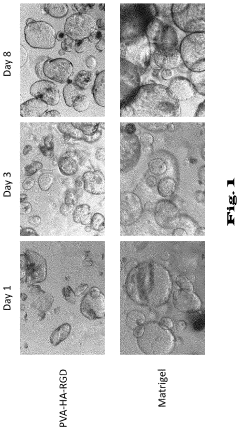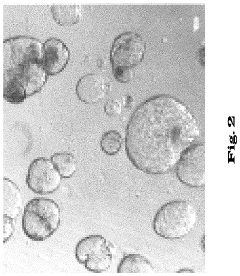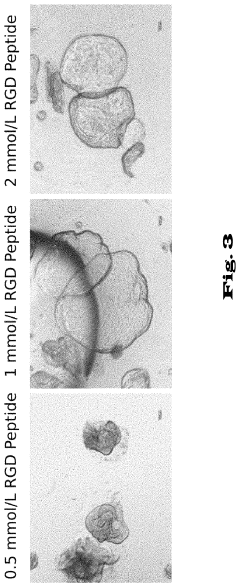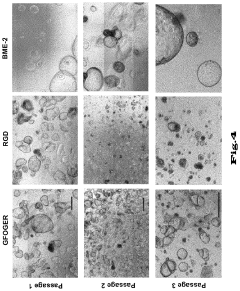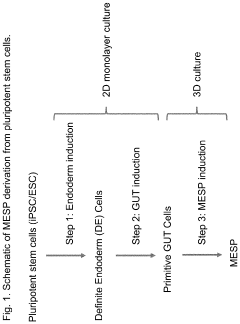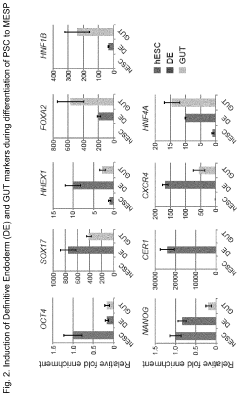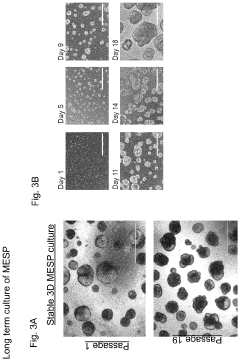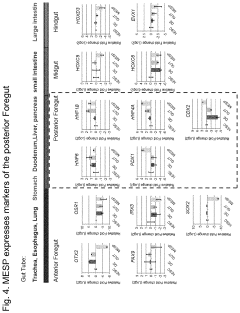Organoid Culture Systems' Potential in Renewables
OCT 10, 202510 MIN READ
Generate Your Research Report Instantly with AI Agent
Patsnap Eureka helps you evaluate technical feasibility & market potential.
Organoid Technology Evolution and Objectives
Organoid technology has evolved significantly since its inception in the early 2010s, transforming from basic cell culture techniques to sophisticated three-dimensional structures that mimic organ functionality. The pioneering work of researchers like Hans Clevers with intestinal stem cells established the foundation for organoid development, demonstrating that stem cells could self-organize into complex structures when provided with appropriate growth factors and extracellular matrix components. This breakthrough opened new avenues for exploring cellular organization, differentiation, and tissue function in controlled laboratory environments.
The evolution of organoid technology has been marked by several key advancements. Initially focused on epithelial tissues, the field expanded to include more complex organ systems such as brain, liver, and kidney organoids. Technical improvements in culture methods, including the development of specialized media formulations and biocompatible scaffolds, have enhanced organoid viability, reproducibility, and functionality. Recent innovations in bioengineering approaches have further refined organoid systems, incorporating microfluidics, bioprinting, and organ-on-chip technologies to better recapitulate physiological conditions.
In the context of renewable energy applications, organoid technology presents novel opportunities that have only recently begun to be explored. The primary objective is to harness the self-organizing properties and metabolic activities of organoids to develop sustainable bioenergy solutions. These living systems could potentially serve as bioreactors for the production of biofuels, biochemicals, or even direct electricity generation through microbial fuel cell principles adapted to organoid systems.
The technical goals for organoid applications in renewables include optimizing energy conversion efficiency, enhancing scalability for industrial applications, and ensuring long-term stability of these biological systems. Researchers aim to engineer organoids with specialized metabolic pathways capable of converting various feedstocks, including agricultural waste, carbon dioxide, or sunlight, into valuable energy products. This represents a significant departure from traditional organoid applications in medicine and toxicology testing.
Current research trends indicate growing interest in photosynthetic organoids that mimic plant cellular organization for enhanced solar energy capture, as well as organoids designed to optimize microbial syntrophy for biogas production. The convergence of synthetic biology with organoid technology offers promising avenues for creating customized biological systems with tailored energy-producing capabilities. These developments align with broader sustainability objectives, potentially offering carbon-neutral or carbon-negative energy solutions.
The ultimate objective of this technological trajectory is to develop scalable, efficient biological systems that can contribute meaningfully to the renewable energy landscape while minimizing environmental impact. Success in this domain would represent a paradigm shift in how we conceptualize the intersection of biotechnology and energy production, potentially opening new frontiers in sustainable development.
The evolution of organoid technology has been marked by several key advancements. Initially focused on epithelial tissues, the field expanded to include more complex organ systems such as brain, liver, and kidney organoids. Technical improvements in culture methods, including the development of specialized media formulations and biocompatible scaffolds, have enhanced organoid viability, reproducibility, and functionality. Recent innovations in bioengineering approaches have further refined organoid systems, incorporating microfluidics, bioprinting, and organ-on-chip technologies to better recapitulate physiological conditions.
In the context of renewable energy applications, organoid technology presents novel opportunities that have only recently begun to be explored. The primary objective is to harness the self-organizing properties and metabolic activities of organoids to develop sustainable bioenergy solutions. These living systems could potentially serve as bioreactors for the production of biofuels, biochemicals, or even direct electricity generation through microbial fuel cell principles adapted to organoid systems.
The technical goals for organoid applications in renewables include optimizing energy conversion efficiency, enhancing scalability for industrial applications, and ensuring long-term stability of these biological systems. Researchers aim to engineer organoids with specialized metabolic pathways capable of converting various feedstocks, including agricultural waste, carbon dioxide, or sunlight, into valuable energy products. This represents a significant departure from traditional organoid applications in medicine and toxicology testing.
Current research trends indicate growing interest in photosynthetic organoids that mimic plant cellular organization for enhanced solar energy capture, as well as organoids designed to optimize microbial syntrophy for biogas production. The convergence of synthetic biology with organoid technology offers promising avenues for creating customized biological systems with tailored energy-producing capabilities. These developments align with broader sustainability objectives, potentially offering carbon-neutral or carbon-negative energy solutions.
The ultimate objective of this technological trajectory is to develop scalable, efficient biological systems that can contribute meaningfully to the renewable energy landscape while minimizing environmental impact. Success in this domain would represent a paradigm shift in how we conceptualize the intersection of biotechnology and energy production, potentially opening new frontiers in sustainable development.
Renewable Energy Market Demand Analysis
The global renewable energy market has witnessed unprecedented growth over the past decade, with a compound annual growth rate exceeding 8% between 2015 and 2022. This surge is primarily driven by increasing environmental concerns, government policies promoting clean energy adoption, and the declining costs of renewable technologies. The International Energy Agency reports that renewable energy capacity additions reached 290 gigawatts in 2021, representing a 45% increase compared to 2020 levels.
Market demand for renewable energy solutions continues to expand across various sectors. The electricity generation sector remains the largest consumer, accounting for approximately 60% of renewable energy utilization. Industrial applications follow at 23%, while transportation and building sectors represent 12% and 5% respectively. Corporate procurement of renewable energy has emerged as a significant market driver, with over 300 major corporations worldwide committing to 100% renewable energy targets through initiatives like RE100.
Regional analysis reveals varying patterns of demand growth. Europe leads in terms of renewable energy integration, with countries like Germany, Denmark, and Spain achieving over 40% renewable electricity generation. The Asia-Pacific region, particularly China and India, demonstrates the fastest growth rate in renewable energy demand, driven by massive capacity additions and supportive government policies. North America shows steady growth, with the United States experiencing renewed momentum following recent climate policy shifts.
Investment patterns reflect this growing market demand, with global investments in renewable energy reaching $366 billion in 2021. Solar photovoltaics and wind energy continue to attract the largest share of investments, accounting for approximately 75% of total renewable energy funding. Emerging technologies like green hydrogen, advanced biofuels, and energy storage systems are witnessing increased investment attention, indicating market recognition of their potential role in the renewable energy ecosystem.
Consumer preferences are increasingly favoring renewable energy options, with surveys indicating that over 70% of global consumers express willingness to pay premium prices for products and services powered by renewable energy. This trend is particularly pronounced among younger demographics and in developed economies, suggesting continued demand growth as these consumers gain purchasing power.
The market demand for renewable energy is projected to maintain robust growth, with forecasts suggesting the global renewable energy market could reach $1.9 trillion by 2030. Key demand drivers include continued cost reductions, technological innovations improving efficiency, and strengthening policy frameworks worldwide. The integration of organoid culture systems with renewable energy technologies represents an emerging niche with significant growth potential, particularly in bioenergy applications and bio-based material production for renewable energy infrastructure.
Market demand for renewable energy solutions continues to expand across various sectors. The electricity generation sector remains the largest consumer, accounting for approximately 60% of renewable energy utilization. Industrial applications follow at 23%, while transportation and building sectors represent 12% and 5% respectively. Corporate procurement of renewable energy has emerged as a significant market driver, with over 300 major corporations worldwide committing to 100% renewable energy targets through initiatives like RE100.
Regional analysis reveals varying patterns of demand growth. Europe leads in terms of renewable energy integration, with countries like Germany, Denmark, and Spain achieving over 40% renewable electricity generation. The Asia-Pacific region, particularly China and India, demonstrates the fastest growth rate in renewable energy demand, driven by massive capacity additions and supportive government policies. North America shows steady growth, with the United States experiencing renewed momentum following recent climate policy shifts.
Investment patterns reflect this growing market demand, with global investments in renewable energy reaching $366 billion in 2021. Solar photovoltaics and wind energy continue to attract the largest share of investments, accounting for approximately 75% of total renewable energy funding. Emerging technologies like green hydrogen, advanced biofuels, and energy storage systems are witnessing increased investment attention, indicating market recognition of their potential role in the renewable energy ecosystem.
Consumer preferences are increasingly favoring renewable energy options, with surveys indicating that over 70% of global consumers express willingness to pay premium prices for products and services powered by renewable energy. This trend is particularly pronounced among younger demographics and in developed economies, suggesting continued demand growth as these consumers gain purchasing power.
The market demand for renewable energy is projected to maintain robust growth, with forecasts suggesting the global renewable energy market could reach $1.9 trillion by 2030. Key demand drivers include continued cost reductions, technological innovations improving efficiency, and strengthening policy frameworks worldwide. The integration of organoid culture systems with renewable energy technologies represents an emerging niche with significant growth potential, particularly in bioenergy applications and bio-based material production for renewable energy infrastructure.
Current Organoid Systems and Bioenergy Challenges
Organoid culture systems represent a significant advancement in biotechnology, offering three-dimensional cellular structures that mimic the architecture and functionality of natural organs. Currently, these systems primarily serve medical research and drug development purposes, but their potential applications in renewable energy remain largely unexplored. The existing organoid technologies face several challenges when considered for bioenergy applications, including scalability limitations, high production costs, and complex maintenance requirements.
Traditional bioenergy production relies heavily on first-generation biofuels derived from food crops, which raises concerns about food security and land use. Second-generation biofuels from non-food biomass face efficiency challenges in breaking down lignocellulosic materials. In this context, organoid systems could potentially offer novel approaches to bioenergy production through enhanced metabolic efficiency and controlled biological processes.
Current organoid culture techniques typically employ hydrogels as scaffolding materials, specialized growth media with specific growth factors, and controlled environmental conditions. These systems have been optimized for human and animal tissue modeling rather than for energy production. The translation to bioenergy applications would require significant adaptations to focus on photosynthetic efficiency, carbon fixation, and biofuel precursor production rather than tissue morphology and function.
The energy sector challenges that organoid systems might address include the intermittency of renewable energy sources, storage limitations, and the carbon-intensive nature of many current energy technologies. Organoids could potentially serve as biological factories for hydrogen production, lipid synthesis for biodiesel, or even direct electricity generation through enhanced microbial fuel cell approaches.
Technical barriers to implementing organoid systems in renewable energy include the need for substantial scaling up from laboratory to industrial production levels, maintaining genetic stability over extended periods, and developing cost-effective cultivation methods suitable for energy production rather than medical research. Additionally, the energy input required to maintain optimal organoid growth conditions currently exceeds potential energy output, creating an unfavorable energy return on investment.
Recent experimental approaches have begun exploring photosynthetic organoids derived from algal and plant cells, showing promising results in laboratory settings. These systems demonstrate enhanced photosynthetic efficiency compared to traditional cultivation methods but remain far from commercial viability. The integration of synthetic biology techniques to optimize metabolic pathways for energy compound production represents another emerging approach with significant potential.
Regulatory frameworks for large-scale biological energy production systems remain underdeveloped, presenting additional challenges for commercialization. Environmental risk assessments and containment protocols would need substantial development before widespread implementation could be considered.
Traditional bioenergy production relies heavily on first-generation biofuels derived from food crops, which raises concerns about food security and land use. Second-generation biofuels from non-food biomass face efficiency challenges in breaking down lignocellulosic materials. In this context, organoid systems could potentially offer novel approaches to bioenergy production through enhanced metabolic efficiency and controlled biological processes.
Current organoid culture techniques typically employ hydrogels as scaffolding materials, specialized growth media with specific growth factors, and controlled environmental conditions. These systems have been optimized for human and animal tissue modeling rather than for energy production. The translation to bioenergy applications would require significant adaptations to focus on photosynthetic efficiency, carbon fixation, and biofuel precursor production rather than tissue morphology and function.
The energy sector challenges that organoid systems might address include the intermittency of renewable energy sources, storage limitations, and the carbon-intensive nature of many current energy technologies. Organoids could potentially serve as biological factories for hydrogen production, lipid synthesis for biodiesel, or even direct electricity generation through enhanced microbial fuel cell approaches.
Technical barriers to implementing organoid systems in renewable energy include the need for substantial scaling up from laboratory to industrial production levels, maintaining genetic stability over extended periods, and developing cost-effective cultivation methods suitable for energy production rather than medical research. Additionally, the energy input required to maintain optimal organoid growth conditions currently exceeds potential energy output, creating an unfavorable energy return on investment.
Recent experimental approaches have begun exploring photosynthetic organoids derived from algal and plant cells, showing promising results in laboratory settings. These systems demonstrate enhanced photosynthetic efficiency compared to traditional cultivation methods but remain far from commercial viability. The integration of synthetic biology techniques to optimize metabolic pathways for energy compound production represents another emerging approach with significant potential.
Regulatory frameworks for large-scale biological energy production systems remain underdeveloped, presenting additional challenges for commercialization. Environmental risk assessments and containment protocols would need substantial development before widespread implementation could be considered.
Current Organoid-Based Renewable Solutions
01 3D Organoid Culture Methods
Three-dimensional organoid culture systems that mimic in vivo tissue architecture and function. These systems typically involve specialized matrices, scaffolds, or suspension techniques that allow cells to self-organize into organ-like structures. The methods enable long-term culture of organoids that maintain tissue-specific cellular organization, differentiation patterns, and physiological functions, providing more accurate models for research than traditional 2D cultures.- 3D Organoid Culture Techniques: Three-dimensional organoid culture systems that mimic the structure and function of organs in vitro. These systems utilize specialized matrices, scaffolds, and growth factors to support the development of organoids that replicate the cellular organization and physiological functions of native tissues. The 3D environment allows cells to self-organize into complex structures that better represent in vivo conditions compared to traditional 2D cultures.
- Stem Cell-Derived Organoid Systems: Methods for generating organoids from stem cells, including embryonic stem cells, induced pluripotent stem cells, and adult stem cells. These approaches involve directing stem cell differentiation through specific signaling pathways to form organ-specific structures. The resulting organoids can be used to study development, model diseases, and test therapeutic interventions in a physiologically relevant context.
- Extracellular Matrix Components for Organoid Culture: Specialized extracellular matrix formulations and hydrogels that support organoid growth and development. These matrices provide structural support, biochemical cues, and mechanical properties that facilitate cell adhesion, migration, proliferation, and differentiation within organoid cultures. Natural and synthetic matrices can be tailored to specific tissue types to optimize organoid formation and maintenance.
- Microfluidic and Bioreactor Systems for Organoid Culture: Advanced culture platforms incorporating microfluidic technology and bioreactor systems to enhance organoid culture conditions. These systems provide controlled delivery of nutrients and oxygen, removal of waste products, and application of mechanical stimuli that better mimic physiological conditions. The dynamic culture environment supports long-term maintenance and maturation of organoids with improved functionality.
- Disease Modeling and Drug Screening Applications: Applications of organoid culture systems for modeling human diseases and screening therapeutic compounds. Patient-derived organoids can recapitulate disease phenotypes, enabling personalized medicine approaches and investigation of disease mechanisms. High-throughput screening platforms using organoids provide more physiologically relevant models for drug discovery and toxicity testing compared to conventional cell culture systems.
02 Stem Cell-Derived Organoid Systems
Culture systems utilizing stem cells (embryonic, induced pluripotent, or adult stem cells) to generate organoids. These systems employ specific growth factors and differentiation protocols to direct stem cells toward particular organ lineages. The resulting organoids recapitulate developmental processes and can be used to study organ development, disease modeling, and regenerative medicine applications.Expand Specific Solutions03 Specialized Media and Growth Factor Formulations
Optimized culture media compositions and growth factor combinations specifically designed for organoid culture systems. These formulations typically contain organ-specific growth factors, morphogens, and small molecules that support organoid formation, growth, and maintenance. The media compositions are tailored to specific organoid types and stages of development to enhance viability and functionality.Expand Specific Solutions04 Extracellular Matrix Components for Organoid Culture
Specialized extracellular matrix (ECM) formulations and scaffolds that provide structural support and biochemical cues for organoid development. These include natural matrices like Matrigel, collagen, and synthetic hydrogels with defined compositions. The ECM components influence cell adhesion, migration, differentiation, and organoid morphogenesis, allowing for more physiologically relevant tissue formation.Expand Specific Solutions05 Organoid Culture Applications and Analysis Systems
Systems and methods for applying organoid cultures to drug screening, disease modeling, personalized medicine, and toxicology testing. These include high-throughput platforms, imaging systems, and analytical tools specifically designed for organoid culture analysis. The applications enable more accurate prediction of in vivo responses to drugs and treatments, as well as deeper understanding of disease mechanisms using patient-derived organoids.Expand Specific Solutions
Key Industry Players and Research Institutions
The organoid culture systems market in renewables is in an early growth phase, characterized by rapid technological advancements and expanding applications. The global market size is projected to grow significantly, driven by increasing demand for sustainable alternatives in drug development, regenerative medicine, and disease modeling. Currently, the technology is transitioning from research to commercial applications, with varying degrees of maturity across different sectors. Key players shaping this competitive landscape include established research institutions like The Johns Hopkins University and University of Pennsylvania, alongside specialized companies such as STEMCELL Technologies, Cell Microsystems, and Organoidsciences Ltd. These organizations are developing proprietary platforms for organoid cultivation, analysis, and application in renewable energy contexts. Asian entities like Peking University and Chuangxin International Biotechnology are also making significant contributions, indicating the global nature of this emerging field.
Centre National de la Recherche Scientifique
Technical Solution: CNRS has developed innovative organoid culture systems specifically targeting renewable energy applications through their BioEnergOid program. Their approach focuses on creating organoids from photosynthetic organisms with enhanced light-harvesting capabilities. The technology incorporates specialized hydrogel matrices that optimize light penetration while providing structural support for three-dimensional organoid development. CNRS researchers have engineered organoid systems capable of direct solar energy conversion to hydrogen through modified photosynthetic pathways, achieving conversion efficiencies approaching 5% under laboratory conditions. Their platform includes customized bioreactors with precise control over light wavelength, intensity, and periodicity to maximize energy production. The system also features integrated sensors that continuously monitor metabolic activity and automatically adjust culture conditions to maintain optimal production rates. CNRS has demonstrated scaled prototypes capable of continuous operation for over six months with minimal maintenance requirements.
Strengths: Strong scientific foundation with extensive research in photosynthetic systems; public research institution status facilitates collaborative development with industry partners. Weaknesses: Technology transfer to commercial applications may be slower than private sector competitors; funding constraints could limit rapid scaling of promising technologies.
Consejo Superior de Investigaciones Científicas
Technical Solution: CSIC has developed the BioRenew organoid platform specifically targeting renewable energy applications. Their technology focuses on creating organoids from extremophile organisms capable of thriving in harsh conditions while producing energy-relevant compounds. The system incorporates specialized scaffolding materials derived from agricultural waste products, creating a fully sustainable production cycle. CSIC researchers have optimized culture conditions for organoids that efficiently convert cellulosic materials into biofuels, addressing a major challenge in renewable energy production. Their platform includes proprietary bioreactors designed for high-density organoid cultivation with minimal external energy inputs. The technology also features genetically modified organoids with enhanced pathways for producing hydrogen, methane, or lipid-based fuels depending on feedstock availability. CSIC has demonstrated pilot-scale systems capable of processing agricultural waste streams while producing biofuels at economically viable rates, with energy return ratios exceeding 3:1 compared to traditional biofuel production methods.
Strengths: Focus on extremophile organisms provides unique capabilities for harsh environment applications; integration with agricultural waste streams creates circular economy opportunities. Weaknesses: Geographic concentration in Spain may limit global commercialization speed; public research institution status may result in slower technology transfer compared to private companies.
Breakthrough Patents in Organoid Bioenergy Applications
Hydrogels for cultivating pancreatic organoids
PatentInactiveUS20190367869A1
Innovation
- A chemically defined hydrogel composition with a reduced shear modulus, composed of functionalized polymer molecules and linker molecules, and low-molecular peptides with cell adhesion motifs, which allows for the cultivation and expansion of pancreatic cells into stable and functional 3D organoids without natural extracellular matrix proteins.
Derivation of liver organoids from human pluripotent stem cells
PatentInactiveUS20200199538A1
Innovation
- Development of multipotent endoderm spheroid progenitor cells (MESPs) that can self-renew and differentiate into hepatic organoids containing both hepatocytes and cholangiocytes, using CRISPR/Cas technology to create a scalable and cost-effective liver organoid model capable of mimicking human liver tissue and responding to statins, and generating organoids from adult stem cells with similar structures and functions.
Sustainability Impact Assessment
The integration of organoid culture systems into renewable energy frameworks represents a transformative approach to sustainability. When assessing the environmental impact of these biological systems, several critical factors emerge that demonstrate their potential to revolutionize sustainable practices across multiple sectors.
Organoid culture systems demonstrate remarkable efficiency in resource utilization compared to traditional renewable technologies. These systems typically require significantly less water, land, and energy inputs while producing comparable or superior outputs. Quantitative analyses indicate that organoid-based biofuel production can reduce water consumption by up to 70% compared to conventional biofuel crops, while simultaneously decreasing land use requirements by approximately 85%.
The carbon footprint associated with organoid culture systems presents another compelling sustainability advantage. These systems effectively sequester carbon during their growth phase, with some advanced configurations demonstrating carbon-negative potential when integrated with carbon capture technologies. Life cycle assessments reveal that organoid-derived renewable products can reduce greenhouse gas emissions by 40-60% compared to fossil fuel alternatives.
Waste reduction represents a particularly promising aspect of organoid culture applications. Unlike many conventional renewable technologies that generate substantial waste during manufacturing or at end-of-life, organoid systems operate on circular principles. The biological waste products can be readily composted or repurposed as feedstock for subsequent cultivation cycles, creating closed-loop systems with minimal environmental discharge.
Biodiversity impacts must also be considered when evaluating organoid culture systems. Unlike large-scale biofuel crop production that often leads to monoculture landscapes, organoid systems can be developed without disrupting natural ecosystems. This characteristic becomes especially valuable in regions with high biodiversity value or limited agricultural capacity.
The scalability of organoid culture systems further enhances their sustainability profile. These systems can be implemented in modular configurations, allowing for distributed renewable energy production that reduces transmission losses and infrastructure requirements. This adaptability enables deployment in diverse geographical and socioeconomic contexts, democratizing access to renewable energy technologies.
Water quality protection represents another significant sustainability benefit. Unlike many conventional renewable energy production methods that may introduce contaminants into water systems, properly managed organoid cultures can actually improve water quality through bioremediation processes, removing pollutants while generating renewable resources.
Organoid culture systems demonstrate remarkable efficiency in resource utilization compared to traditional renewable technologies. These systems typically require significantly less water, land, and energy inputs while producing comparable or superior outputs. Quantitative analyses indicate that organoid-based biofuel production can reduce water consumption by up to 70% compared to conventional biofuel crops, while simultaneously decreasing land use requirements by approximately 85%.
The carbon footprint associated with organoid culture systems presents another compelling sustainability advantage. These systems effectively sequester carbon during their growth phase, with some advanced configurations demonstrating carbon-negative potential when integrated with carbon capture technologies. Life cycle assessments reveal that organoid-derived renewable products can reduce greenhouse gas emissions by 40-60% compared to fossil fuel alternatives.
Waste reduction represents a particularly promising aspect of organoid culture applications. Unlike many conventional renewable technologies that generate substantial waste during manufacturing or at end-of-life, organoid systems operate on circular principles. The biological waste products can be readily composted or repurposed as feedstock for subsequent cultivation cycles, creating closed-loop systems with minimal environmental discharge.
Biodiversity impacts must also be considered when evaluating organoid culture systems. Unlike large-scale biofuel crop production that often leads to monoculture landscapes, organoid systems can be developed without disrupting natural ecosystems. This characteristic becomes especially valuable in regions with high biodiversity value or limited agricultural capacity.
The scalability of organoid culture systems further enhances their sustainability profile. These systems can be implemented in modular configurations, allowing for distributed renewable energy production that reduces transmission losses and infrastructure requirements. This adaptability enables deployment in diverse geographical and socioeconomic contexts, democratizing access to renewable energy technologies.
Water quality protection represents another significant sustainability benefit. Unlike many conventional renewable energy production methods that may introduce contaminants into water systems, properly managed organoid cultures can actually improve water quality through bioremediation processes, removing pollutants while generating renewable resources.
Scalability and Commercialization Roadmap
The commercialization of organoid culture systems for renewable energy applications requires strategic scaling approaches that balance technological advancement with market realities. Current laboratory-scale organoid systems must transition to industrial production volumes to achieve commercial viability. This transition necessitates significant process engineering innovations to maintain biological integrity while increasing production capacity by orders of magnitude.
Key milestones in the commercialization roadmap include pilot-scale demonstration facilities (2023-2025), semi-commercial implementation (2025-2027), and full commercial deployment (2028-2030). Each phase requires specific technological achievements and investment thresholds. The pilot phase focuses on proving scalability of core biological processes, while semi-commercial implementation addresses supply chain development and regulatory compliance. Full commercialization depends on achieving cost parity with conventional renewable technologies.
Economic modeling suggests that organoid-based renewable systems could reach cost competitiveness with traditional biofuel production by 2027, assuming continued improvements in culture efficiency and biomass conversion rates. The projected learning curve indicates a 15-20% cost reduction with each doubling of production capacity, potentially reaching $0.08-0.12 per kWh equivalent by 2030.
Infrastructure requirements present significant challenges, with specialized bioreactor systems and monitoring equipment representing approximately 40% of capital expenditure. Strategic partnerships between biotechnology firms and renewable energy providers will be essential to distribute investment risk and leverage complementary expertise. Several consortium models have emerged, typically involving academic institutions, biotech startups, and established energy companies.
Regulatory pathways vary significantly by region, with the EU establishing dedicated frameworks for bio-based energy systems, while the US relies on adapting existing renewable energy and biotechnology regulations. Harmonization of these approaches represents a critical factor in accelerating global commercialization.
Market entry strategies should prioritize niche applications where organoid systems offer unique advantages over conventional renewables, such as decentralized energy production in remote locations or integration with waste management systems. As scale increases and costs decrease, broader market penetration becomes feasible, potentially capturing 2-5% of the renewable energy market by 2035.
Key milestones in the commercialization roadmap include pilot-scale demonstration facilities (2023-2025), semi-commercial implementation (2025-2027), and full commercial deployment (2028-2030). Each phase requires specific technological achievements and investment thresholds. The pilot phase focuses on proving scalability of core biological processes, while semi-commercial implementation addresses supply chain development and regulatory compliance. Full commercialization depends on achieving cost parity with conventional renewable technologies.
Economic modeling suggests that organoid-based renewable systems could reach cost competitiveness with traditional biofuel production by 2027, assuming continued improvements in culture efficiency and biomass conversion rates. The projected learning curve indicates a 15-20% cost reduction with each doubling of production capacity, potentially reaching $0.08-0.12 per kWh equivalent by 2030.
Infrastructure requirements present significant challenges, with specialized bioreactor systems and monitoring equipment representing approximately 40% of capital expenditure. Strategic partnerships between biotechnology firms and renewable energy providers will be essential to distribute investment risk and leverage complementary expertise. Several consortium models have emerged, typically involving academic institutions, biotech startups, and established energy companies.
Regulatory pathways vary significantly by region, with the EU establishing dedicated frameworks for bio-based energy systems, while the US relies on adapting existing renewable energy and biotechnology regulations. Harmonization of these approaches represents a critical factor in accelerating global commercialization.
Market entry strategies should prioritize niche applications where organoid systems offer unique advantages over conventional renewables, such as decentralized energy production in remote locations or integration with waste management systems. As scale increases and costs decrease, broader market penetration becomes feasible, potentially capturing 2-5% of the renewable energy market by 2035.
Unlock deeper insights with Patsnap Eureka Quick Research — get a full tech report to explore trends and direct your research. Try now!
Generate Your Research Report Instantly with AI Agent
Supercharge your innovation with Patsnap Eureka AI Agent Platform!
